
AV-Deepfake1M
[ACM MM Award] AV-Deepfake1M: A Large-Scale LLM-Driven Audio-Visual Deepfake Dataset
Stars: 106
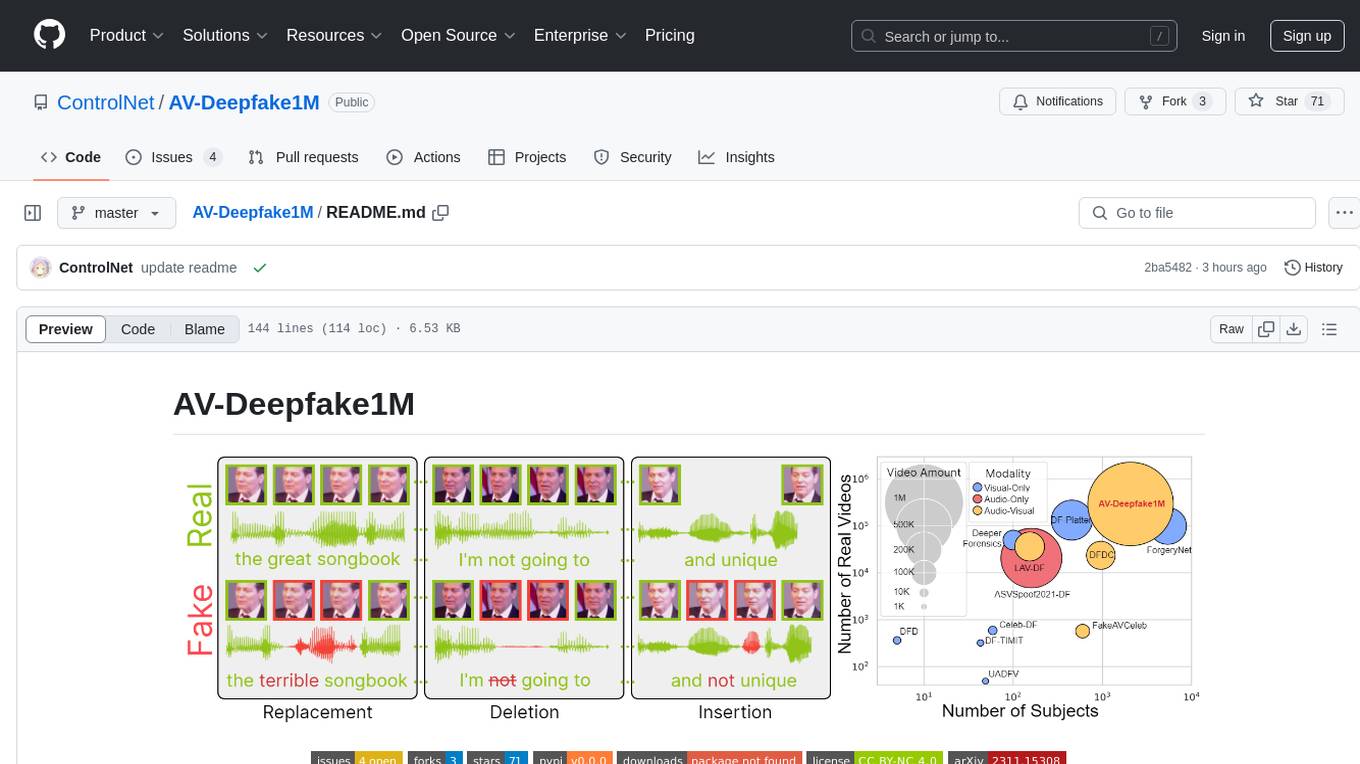
The AV-Deepfake1M repository is the official repository for the paper AV-Deepfake1M: A Large-Scale LLM-Driven Audio-Visual Deepfake Dataset. It addresses the challenge of detecting and localizing deepfake audio-visual content by proposing a dataset containing video manipulations, audio manipulations, and audio-visual manipulations for over 2K subjects resulting in more than 1M videos. The dataset is crucial for developing next-generation deepfake localization methods.
README:
This is the official repository for the paper AV-Deepfake1M: A Large-Scale LLM-Driven Audio-Visual Deepfake Dataset (Best Award).
The detection and localization of highly realistic deepfake audio-visual content are challenging even for the most advanced state-of-the-art methods. While most of the research efforts in this domain are focused on detecting high-quality deepfake images and videos, only a few works address the problem of the localization of small segments of audio-visual manipulations embedded in real videos. In this research, we emulate the process of such content generation and propose the AV-Deepfake1M dataset. The dataset contains content-driven (i) video manipulations, (ii) audio manipulations, and (iii) audio-visual manipulations for more than 2K subjects resulting in a total of more than 1M videos. The paper provides a thorough description of the proposed data generation pipeline accompanied by a rigorous analysis of the quality of the generated data. The comprehensive benchmark of the proposed dataset utilizing state-of-the-art deepfake detection and localization methods indicates a significant drop in performance compared to previous datasets. The proposed dataset will play a vital role in building the next-generation deepfake localization methods.
https://github.com/user-attachments/assets/d91aee8a-0fb5-4dff-ba20-86420332fed5
We're hosting 1M-Deepfakes Detection Challenge at ACM MM 2024.
| Method | [email protected] | [email protected] | [email protected] | [email protected] | AR@50 | AR@20 | AR@10 | AR@5 |
|---|---|---|---|---|---|---|---|---|
| PyAnnote | 00.03 | 00.00 | 00.00 | 00.00 | 00.67 | 00.67 | 00.67 | 00.67 |
| Meso4 | 09.86 | 06.05 | 02.22 | 00.59 | 38.92 | 38.81 | 36.47 | 26.91 |
| MesoInception4 | 08.50 | 05.16 | 01.89 | 00.50 | 39.27 | 39.00 | 35.78 | 24.59 |
| EfficientViT | 14.71 | 02.42 | 00.13 | 00.01 | 27.04 | 26.43 | 23.90 | 20.31 |
| TriDet + VideoMAEv2 | 21.67 | 05.83 | 00.54 | 00.06 | 20.27 | 20.12 | 19.50 | 18.18 |
| TriDet + InternVideo | 29.66 | 09.02 | 00.79 | 00.09 | 24.08 | 23.96 | 23.50 | 22.55 |
| ActionFormer + VideoMAEv2 | 20.24 | 05.73 | 00.57 | 00.07 | 19.97 | 19.81 | 19.11 | 17.80 |
| ActionFormer + InternVideo | 36.08 | 12.01 | 01.23 | 00.16 | 27.11 | 27.00 | 26.60 | 25.80 |
| BA-TFD | 37.37 | 06.34 | 00.19 | 00.02 | 45.55 | 35.95 | 30.66 | 26.82 |
| BA-TFD+ | 44.42 | 13.64 | 00.48 | 00.03 | 48.86 | 40.37 | 34.67 | 29.88 |
| UMMAFormer | 51.64 | 28.07 | 07.65 | 01.58 | 44.07 | 43.45 | 42.09 | 40.27 |
The metadata is a json file for each subset (train, val), which is a list of dictionaries. The fields in the dictionary are as follows.
- file: the path to the video file.
- original: if the current video is fake, the path to the original video; otherwise, the original path in VoxCeleb2.
- split: the name of the current subset.
- modify_type: the type of modifications in different modalities, which can be ["real", "visual_modified", "audio_modified", "both_modified"]. We evaluate the deepfake detection performance based on this field.
- audio_model: the audio generation model used for generating this video.
- fake_segments: the timestamps of the fake segments. We evaluate the temporal localization performance based on this field.
- audio_fake_segments: the timestamps of the fake segments in audio modality.
- visual_fake_segments: the timestamps of the fake segments in visual modality.
- video_frames: the number of frames in the video.
- audio_frames: the number of frames in the audio.
We provide a Python library avdeepfake1m to load the dataset and evaluation.
pip install avdeepfake1mPrepare the dataset as follows.
|- train_metadata.json
|- train_metadata
| |- ...
|- train
| |- ...
|- val_metadata.json
|- val_metadata
| |- ...
|- val
| |- ...
|- test_files.txt
|- test
Load the dataset.
from avdeepfake1m.loader import AVDeepfake1mDataModule
# access to Lightning DataModule
dm = AVDeepfake1mDataModule("/path/to/dataset")Evaluate the predictions. Firstly prepare the predictions as described in the details. Then run the following code.
from avdeepfake1m.evaluation import ap_ar_1d, auc
print(ap_ar_1d("<PREDICTION_JSON>", "<METADATA_JSON>", "file", "fake_segments", 1, [0.5, 0.75, 0.9, 0.95], [50, 30, 20, 10, 5], [0.5, 0.55, 0.6, 0.65, 0.7, 0.75, 0.8, 0.85, 0.9, 0.95]))
print(auc("<PREDICTION_TXT>", "<METADATA_JSON>"))The dataset is under the EULA. You need to agree and sign the EULA to access the dataset.
The other parts of this project is under the CC BY-NC 4.0 license. See LICENSE for details.
If you find this work useful in your research, please cite it.
@inproceedings{cai2024av,
title={AV-Deepfake1M: A large-scale LLM-driven audio-visual deepfake dataset},
author={Cai, Zhixi and Ghosh, Shreya and Adatia, Aman Pankaj and Hayat, Munawar and Dhall, Abhinav and Gedeon, Tom and Stefanov, Kalin},
booktitle={Proceedings of the 32nd ACM International Conference on Multimedia},
pages={7414--7423},
year={2024},
doi={10.1145/3664647.3680795}
}The challenge summary paper:
@inproceedings{cai20241m,
title={1M-Deepfakes Detection Challenge},
author={Cai, Zhixi and Dhall, Abhinav and Ghosh, Shreya and Hayat, Munawar and Kollias, Dimitrios and Stefanov, Kalin and Tariq, Usman},
booktitle={Proceedings of the 32nd ACM International Conference on Multimedia},
pages={11355--11359},
year={2024},
doi={10.1145/3664647.3689145}
}For Tasks:
Click tags to check more tools for each tasksFor Jobs:
Alternative AI tools for AV-Deepfake1M
Similar Open Source Tools

AV-Deepfake1M
The AV-Deepfake1M repository is the official repository for the paper AV-Deepfake1M: A Large-Scale LLM-Driven Audio-Visual Deepfake Dataset. It addresses the challenge of detecting and localizing deepfake audio-visual content by proposing a dataset containing video manipulations, audio manipulations, and audio-visual manipulations for over 2K subjects resulting in more than 1M videos. The dataset is crucial for developing next-generation deepfake localization methods.
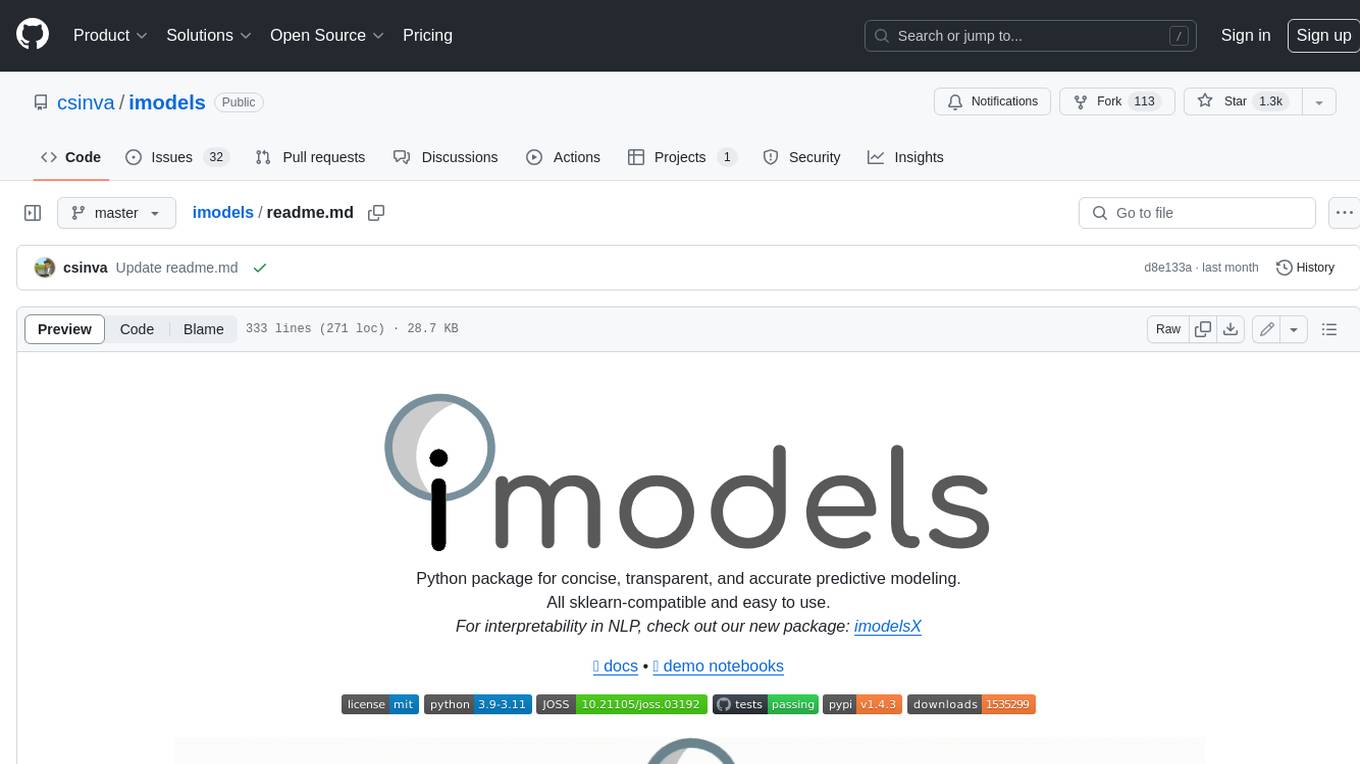
imodels
Python package for concise, transparent, and accurate predictive modeling. All sklearn-compatible and easy to use. _For interpretability in NLP, check out our new package:imodelsX _
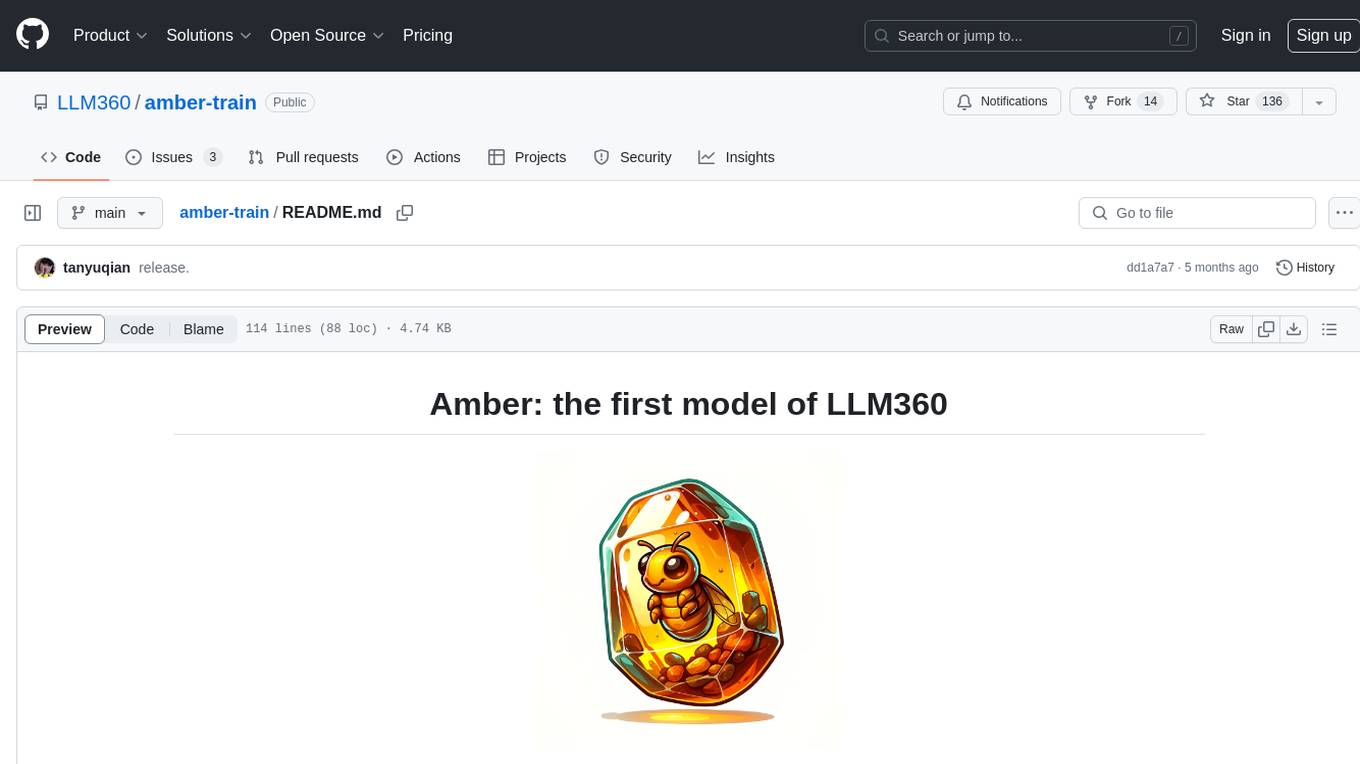
amber-train
Amber is the first model in the LLM360 family, an initiative for comprehensive and fully open-sourced LLMs. It is a 7B English language model with the LLaMA architecture. The model type is a language model with the same architecture as LLaMA-7B. It is licensed under Apache 2.0. The resources available include training code, data preparation, metrics, and fully processed Amber pretraining data. The model has been trained on various datasets like Arxiv, Book, C4, Refined-Web, StarCoder, StackExchange, and Wikipedia. The hyperparameters include a total of 6.7B parameters, hidden size of 4096, intermediate size of 11008, 32 attention heads, 32 hidden layers, RMSNorm ε of 1e^-6, max sequence length of 2048, and a vocabulary size of 32000.

PIXIU
PIXIU is a project designed to support the development, fine-tuning, and evaluation of Large Language Models (LLMs) in the financial domain. It includes components like FinBen, a Financial Language Understanding and Prediction Evaluation Benchmark, FIT, a Financial Instruction Dataset, and FinMA, a Financial Large Language Model. The project provides open resources, multi-task and multi-modal financial data, and diverse financial tasks for training and evaluation. It aims to encourage open research and transparency in the financial NLP field.
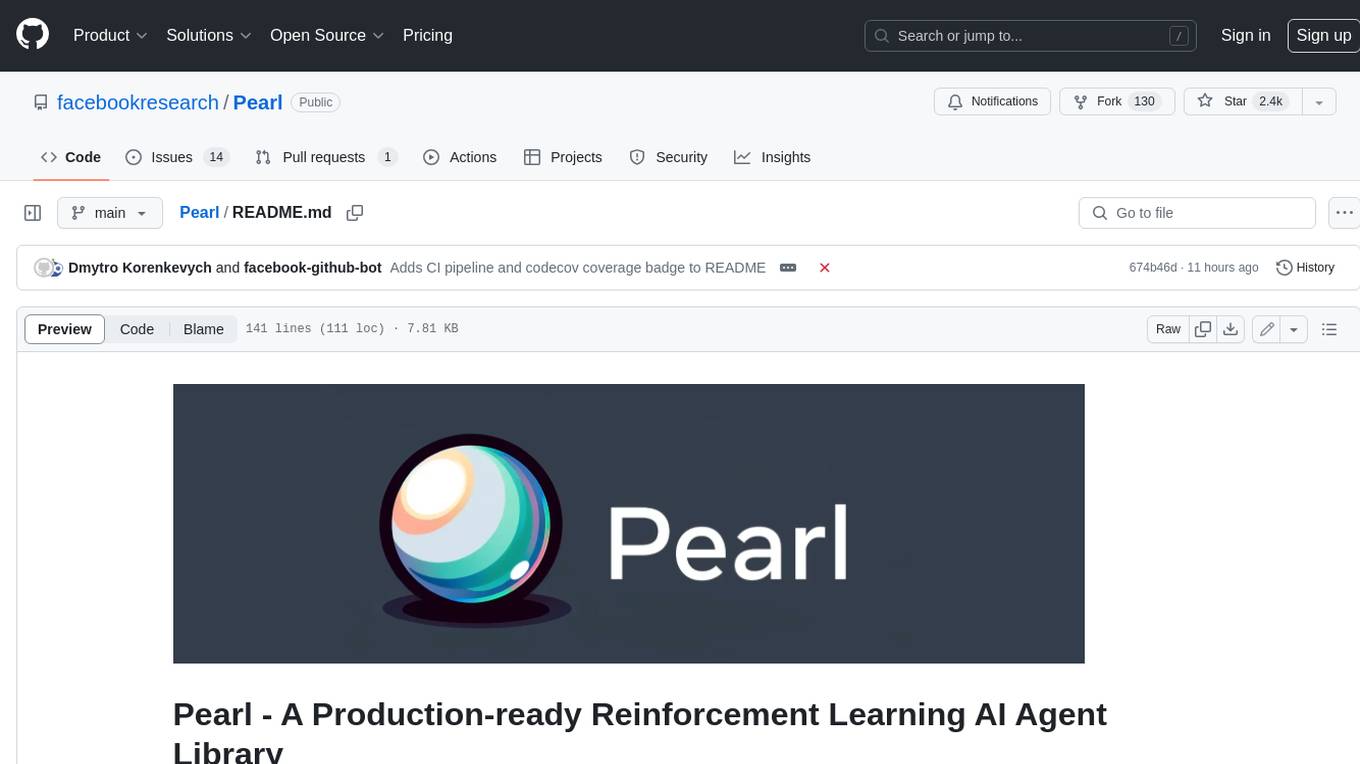
Pearl
Pearl is a production-ready Reinforcement Learning AI agent library open-sourced by the Applied Reinforcement Learning team at Meta. It enables researchers and practitioners to develop Reinforcement Learning AI agents that prioritize cumulative long-term feedback over immediate feedback and can adapt to environments with limited observability, sparse feedback, and high stochasticity. Pearl offers a diverse set of unique features for production environments, including dynamic action spaces, offline learning, intelligent neural exploration, safe decision making, history summarization, and data augmentation.
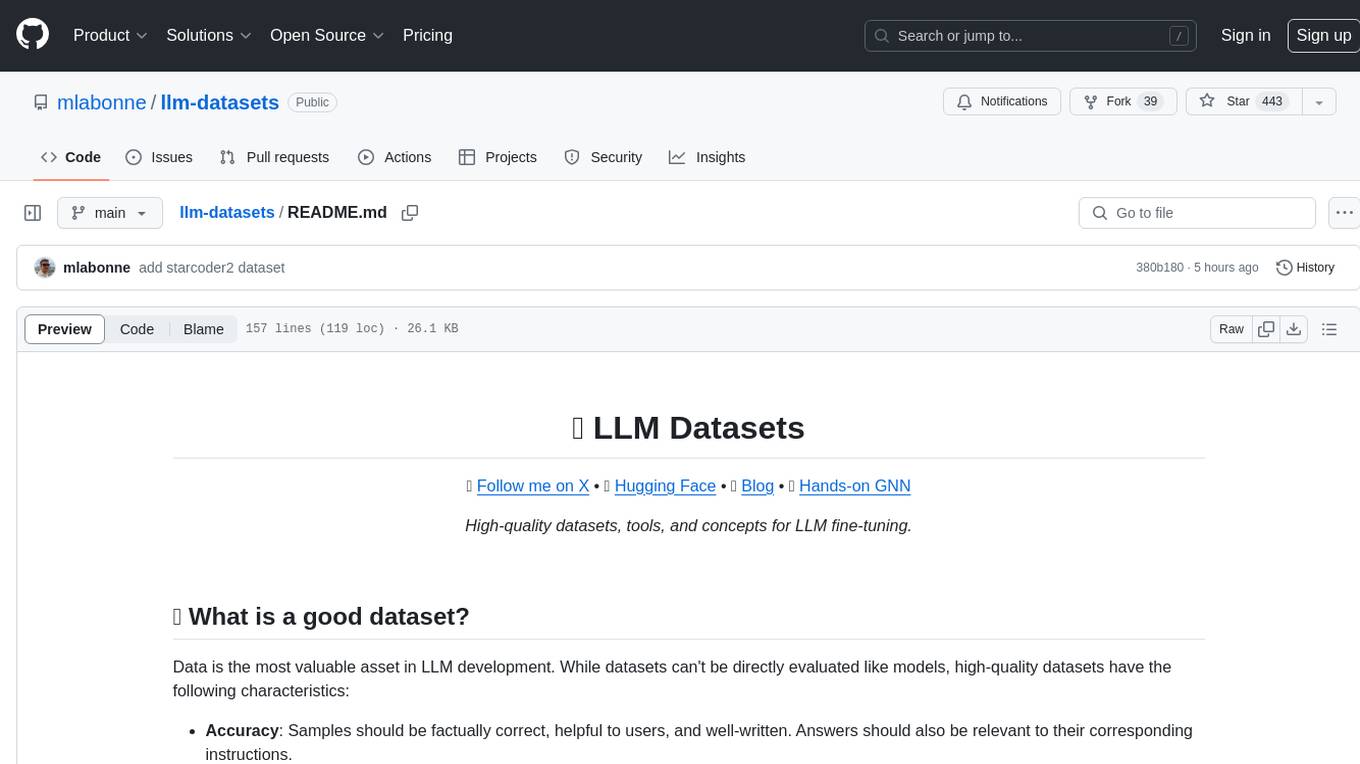
llm-datasets
LLM Datasets is a repository containing high-quality datasets, tools, and concepts for LLM fine-tuning. It provides datasets with characteristics like accuracy, diversity, and complexity to train large language models for various tasks. The repository includes datasets for general-purpose, math & logic, code, conversation & role-play, and agent & function calling domains. It also offers guidance on creating high-quality datasets through data deduplication, data quality assessment, data exploration, and data generation techniques.
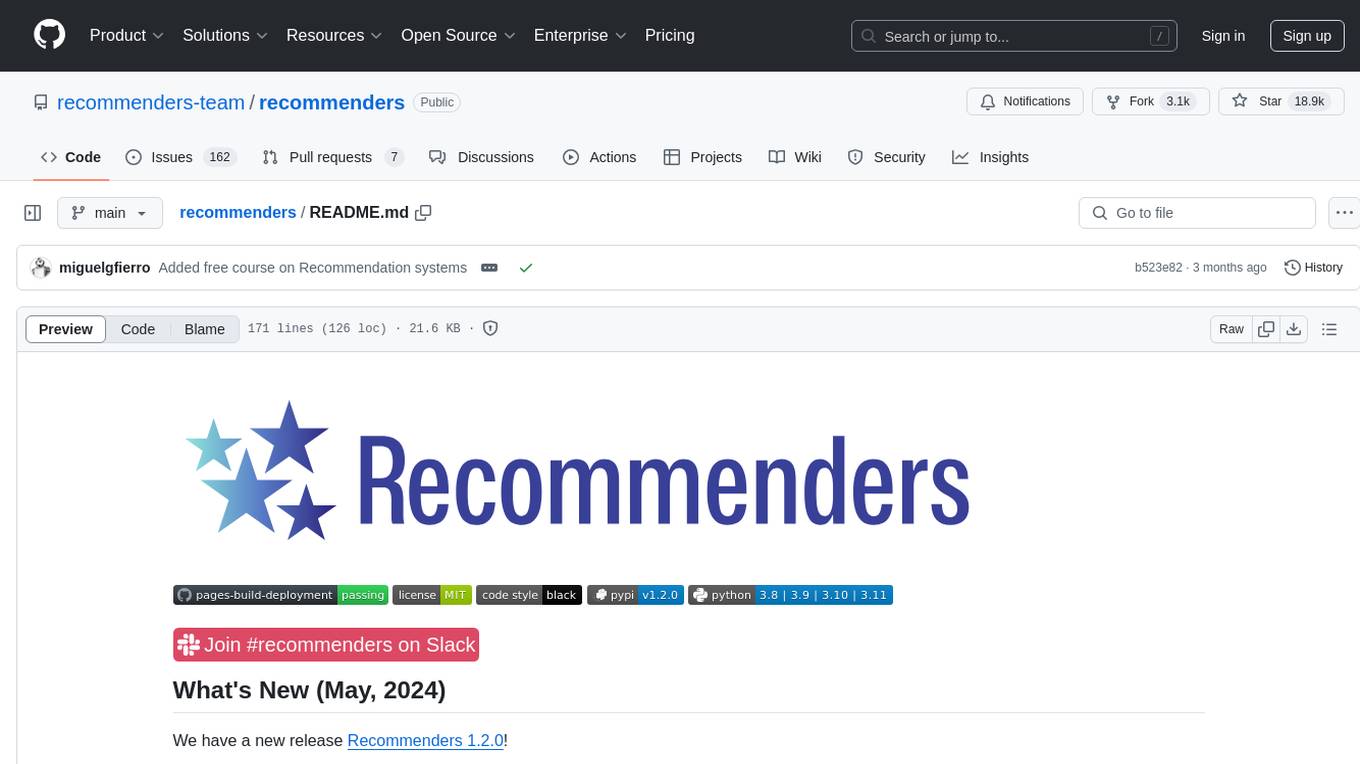
recommenders
Recommenders is a project under the Linux Foundation of AI and Data that assists researchers, developers, and enthusiasts in prototyping, experimenting with, and bringing to production a range of classic and state-of-the-art recommendation systems. The repository contains examples and best practices for building recommendation systems, provided as Jupyter notebooks. It covers tasks such as preparing data, building models using various recommendation algorithms, evaluating algorithms, tuning hyperparameters, and operationalizing models in a production environment on Azure. The project provides utilities to support common tasks like loading datasets, evaluating model outputs, and splitting training/test data. It includes implementations of state-of-the-art algorithms for self-study and customization in applications.
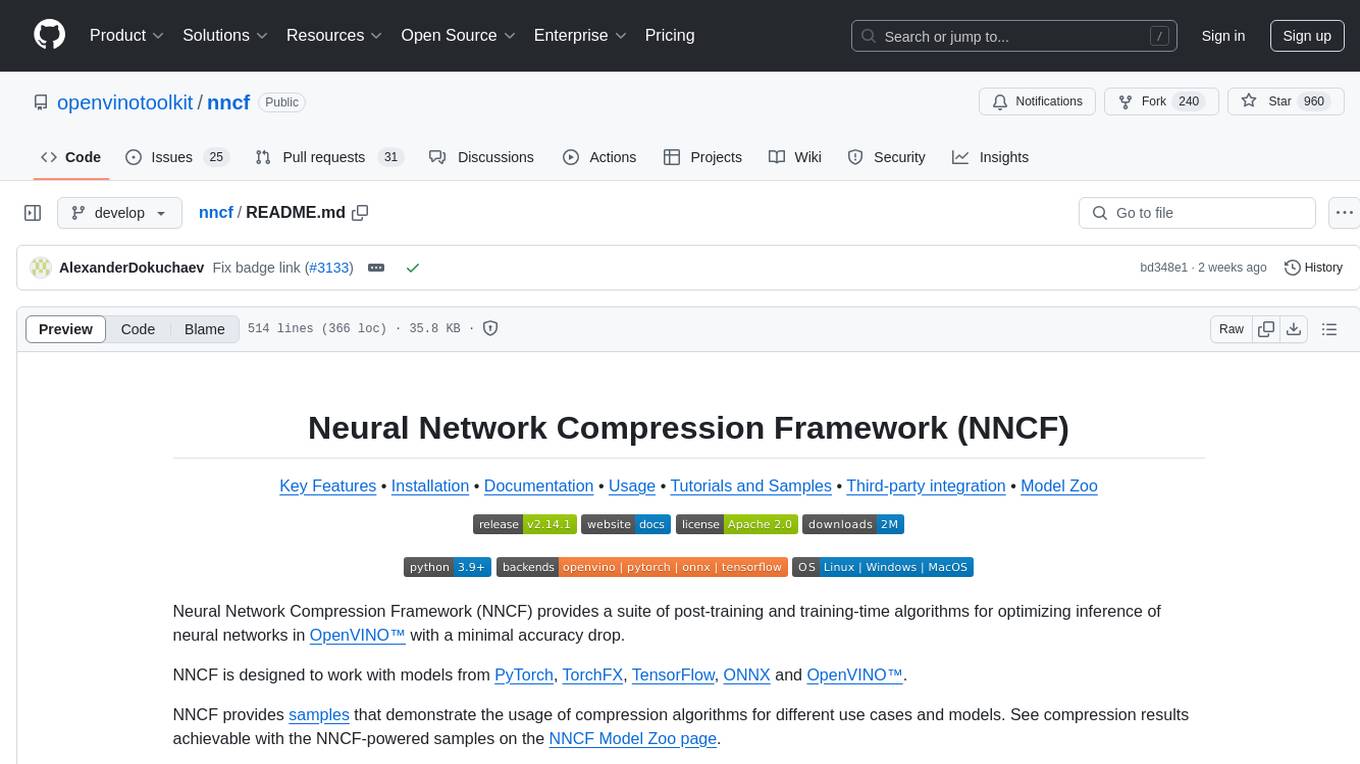
nncf
Neural Network Compression Framework (NNCF) provides a suite of post-training and training-time algorithms for optimizing inference of neural networks in OpenVINO™ with a minimal accuracy drop. It is designed to work with models from PyTorch, TorchFX, TensorFlow, ONNX, and OpenVINO™. NNCF offers samples demonstrating compression algorithms for various use cases and models, with the ability to add different compression algorithms easily. It supports GPU-accelerated layers, distributed training, and seamless combination of pruning, sparsity, and quantization algorithms. NNCF allows exporting compressed models to ONNX or TensorFlow formats for use with OpenVINO™ toolkit, and supports Accuracy-Aware model training pipelines via Adaptive Compression Level Training and Early Exit Training.
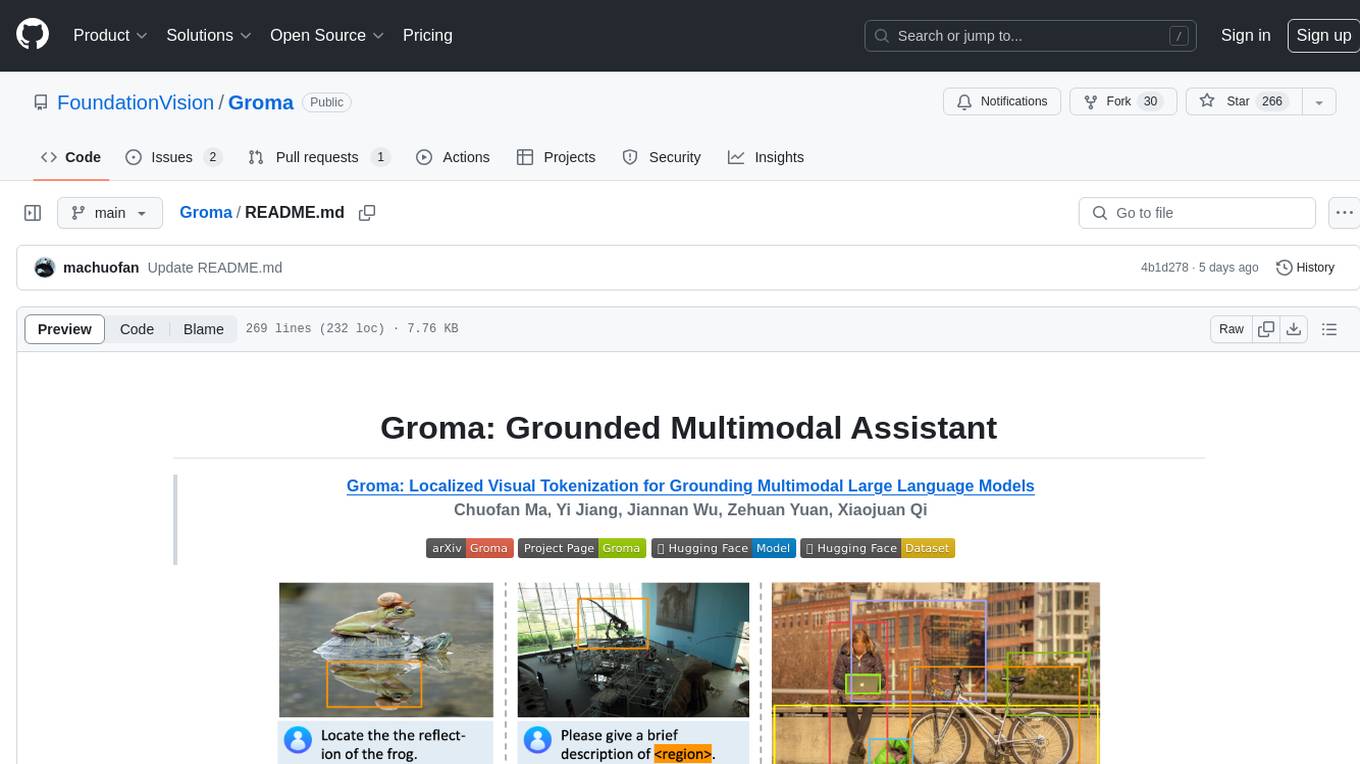
Groma
Groma is a grounded multimodal assistant that excels in region understanding and visual grounding. It can process user-defined region inputs and generate contextually grounded long-form responses. The tool presents a unique paradigm for multimodal large language models, focusing on visual tokenization for localization. Groma achieves state-of-the-art performance in referring expression comprehension benchmarks. The tool provides pretrained model weights and instructions for data preparation, training, inference, and evaluation. Users can customize training by starting from intermediate checkpoints. Groma is designed to handle tasks related to detection pretraining, alignment pretraining, instruction finetuning, instruction following, and more.
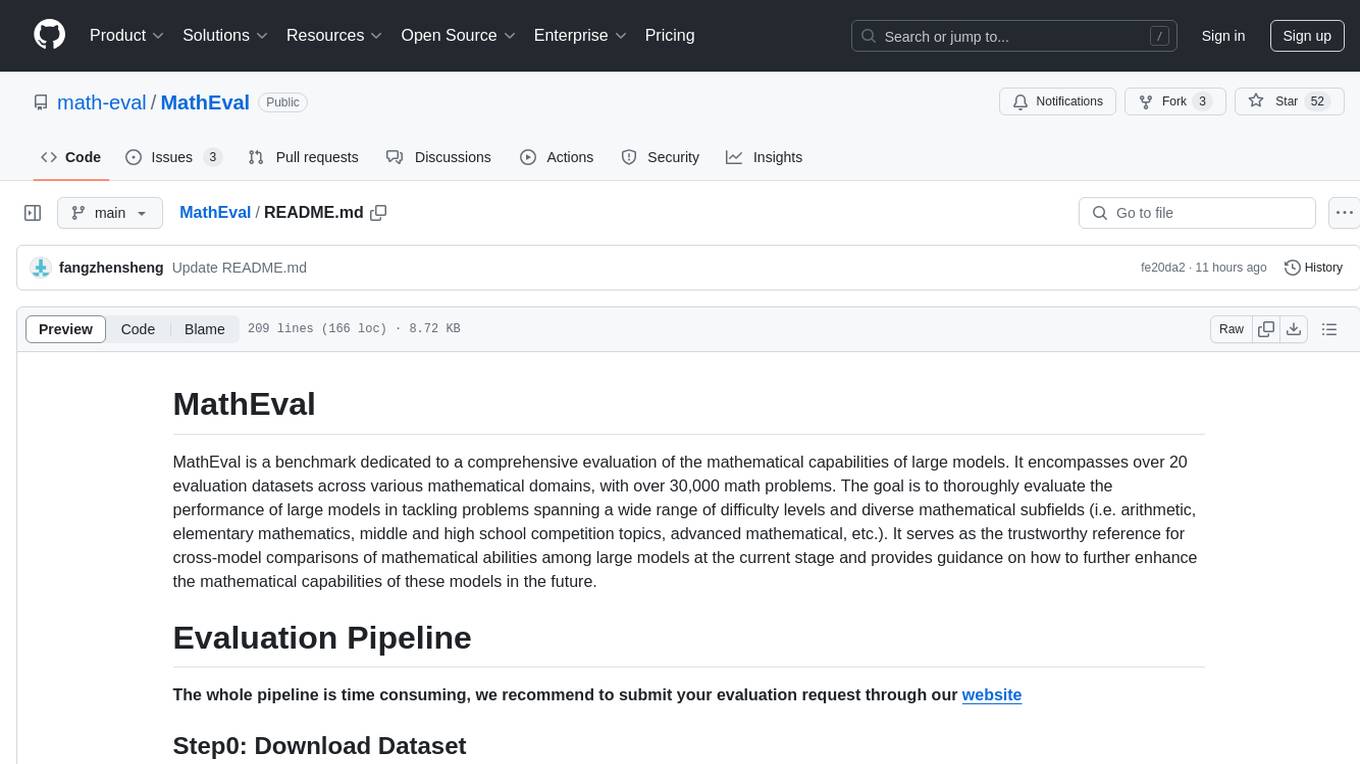
MathEval
MathEval is a benchmark designed for evaluating the mathematical capabilities of large models. It includes over 20 evaluation datasets covering various mathematical domains with more than 30,000 math problems. The goal is to assess the performance of large models across different difficulty levels and mathematical subfields. MathEval serves as a reliable reference for comparing mathematical abilities among large models and offers guidance on enhancing their mathematical capabilities in the future.
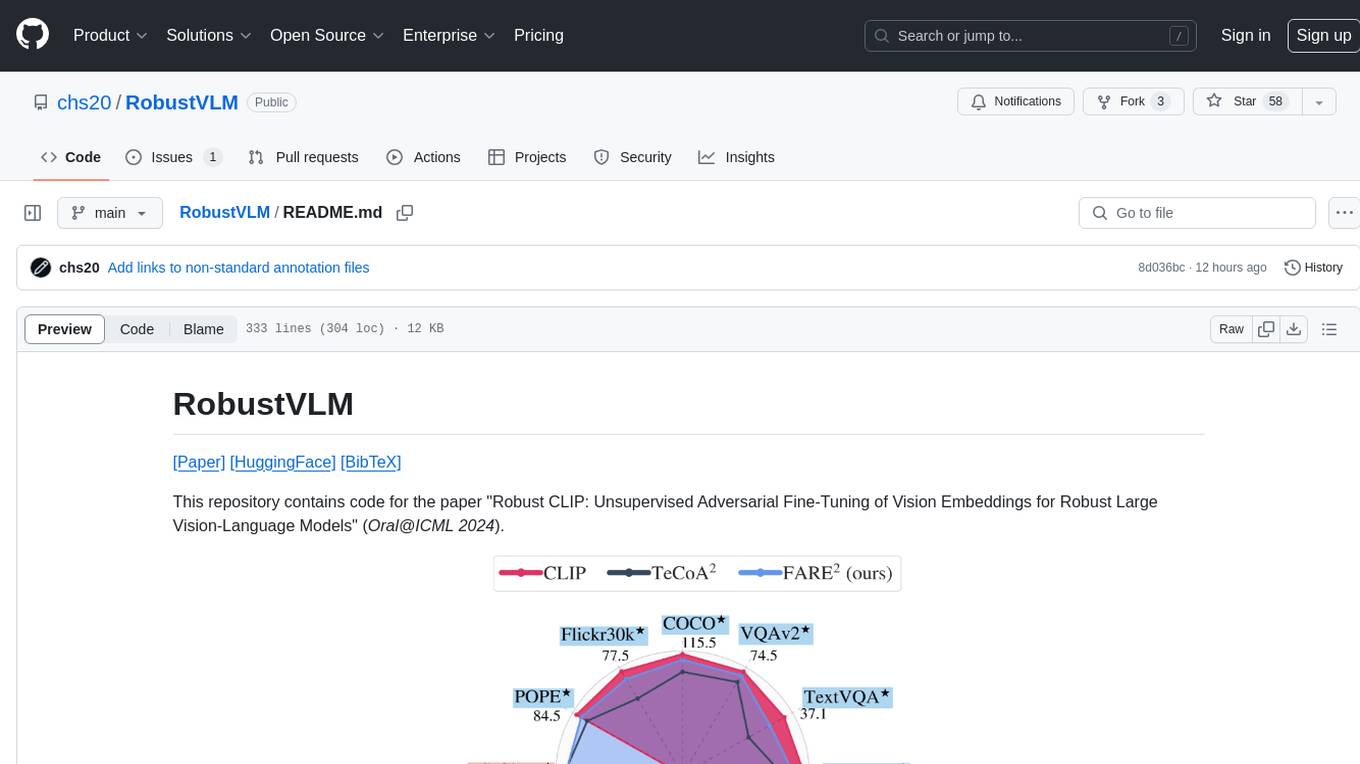
RobustVLM
This repository contains code for the paper 'Robust CLIP: Unsupervised Adversarial Fine-Tuning of Vision Embeddings for Robust Large Vision-Language Models'. It focuses on fine-tuning CLIP in an unsupervised manner to enhance its robustness against visual adversarial attacks. By replacing the vision encoder of large vision-language models with the fine-tuned CLIP models, it achieves state-of-the-art adversarial robustness on various vision-language tasks. The repository provides adversarially fine-tuned ViT-L/14 CLIP models and offers insights into zero-shot classification settings and clean accuracy improvements.
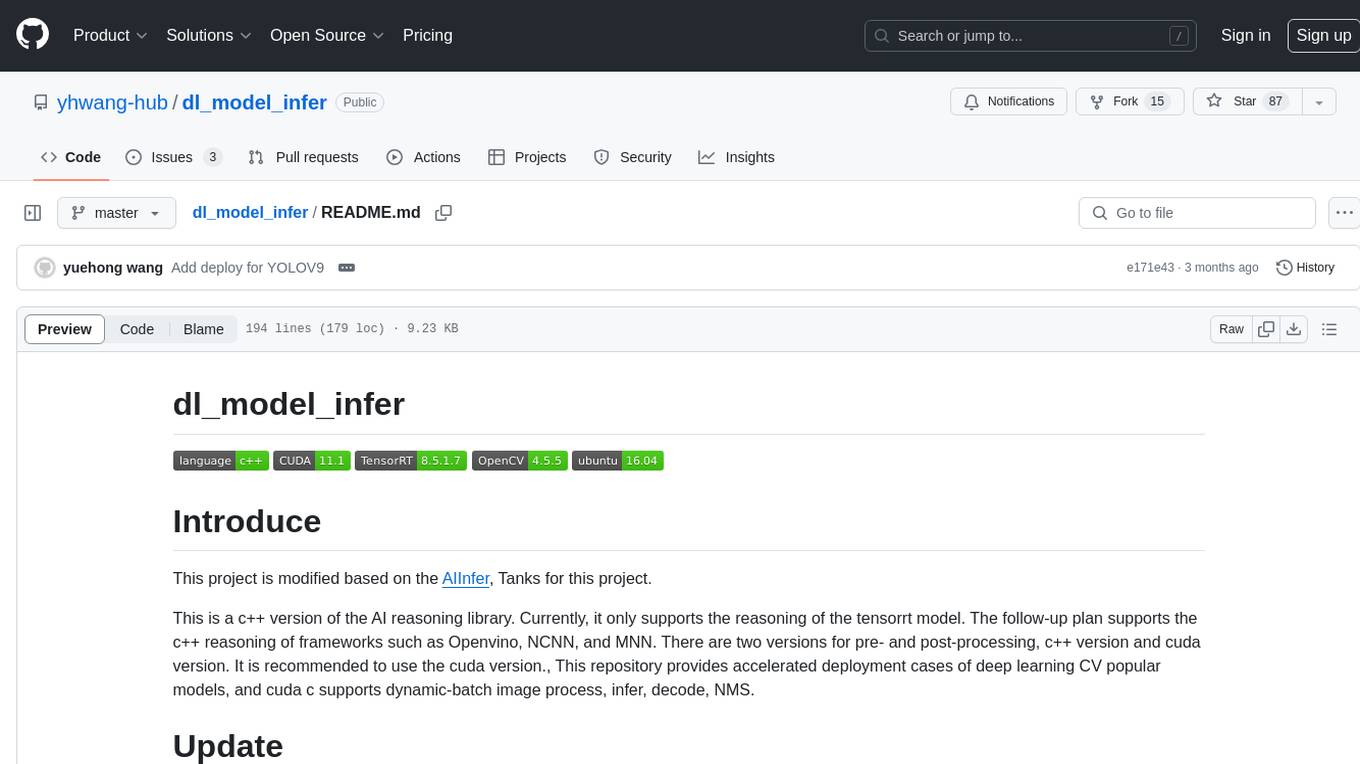
dl_model_infer
This project is a c++ version of the AI reasoning library that supports the reasoning of tensorrt models. It provides accelerated deployment cases of deep learning CV popular models and supports dynamic-batch image processing, inference, decode, and NMS. The project has been updated with various models and provides tutorials for model exports. It also includes a producer-consumer inference model for specific tasks. The project directory includes implementations for model inference applications, backend reasoning classes, post-processing, pre-processing, and target detection and tracking. Speed tests have been conducted on various models, and onnx downloads are available for different models.
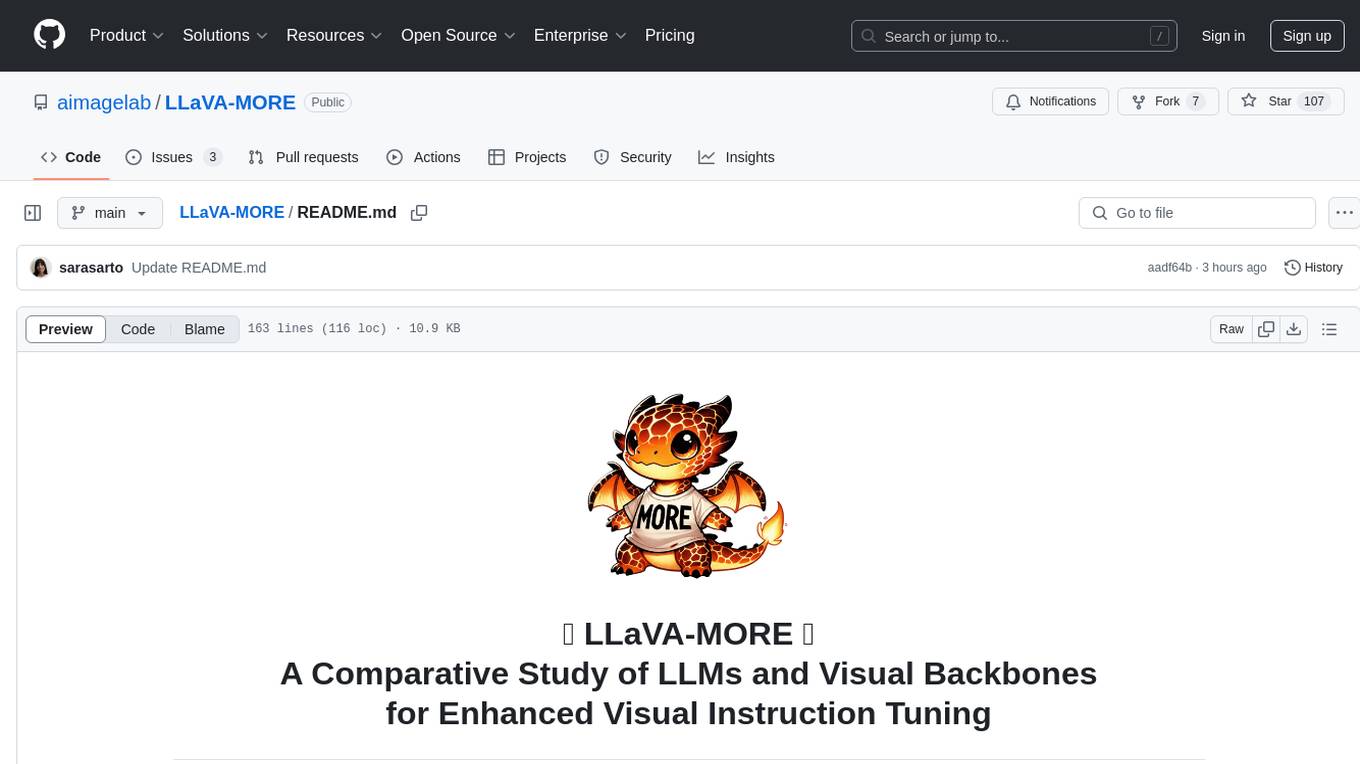
LLaVA-MORE
LLaVA-MORE is a new family of Multimodal Language Models (MLLMs) that integrates recent language models with diverse visual backbones. The repository provides a unified training protocol for fair comparisons across all architectures and releases training code and scripts for distributed training. It aims to enhance Multimodal LLM performance and offers various models for different tasks. Users can explore different visual backbones like SigLIP and methods for managing image resolutions (S2) to improve the connection between images and language. The repository is a starting point for expanding the study of Multimodal LLMs and enhancing new features in the field.
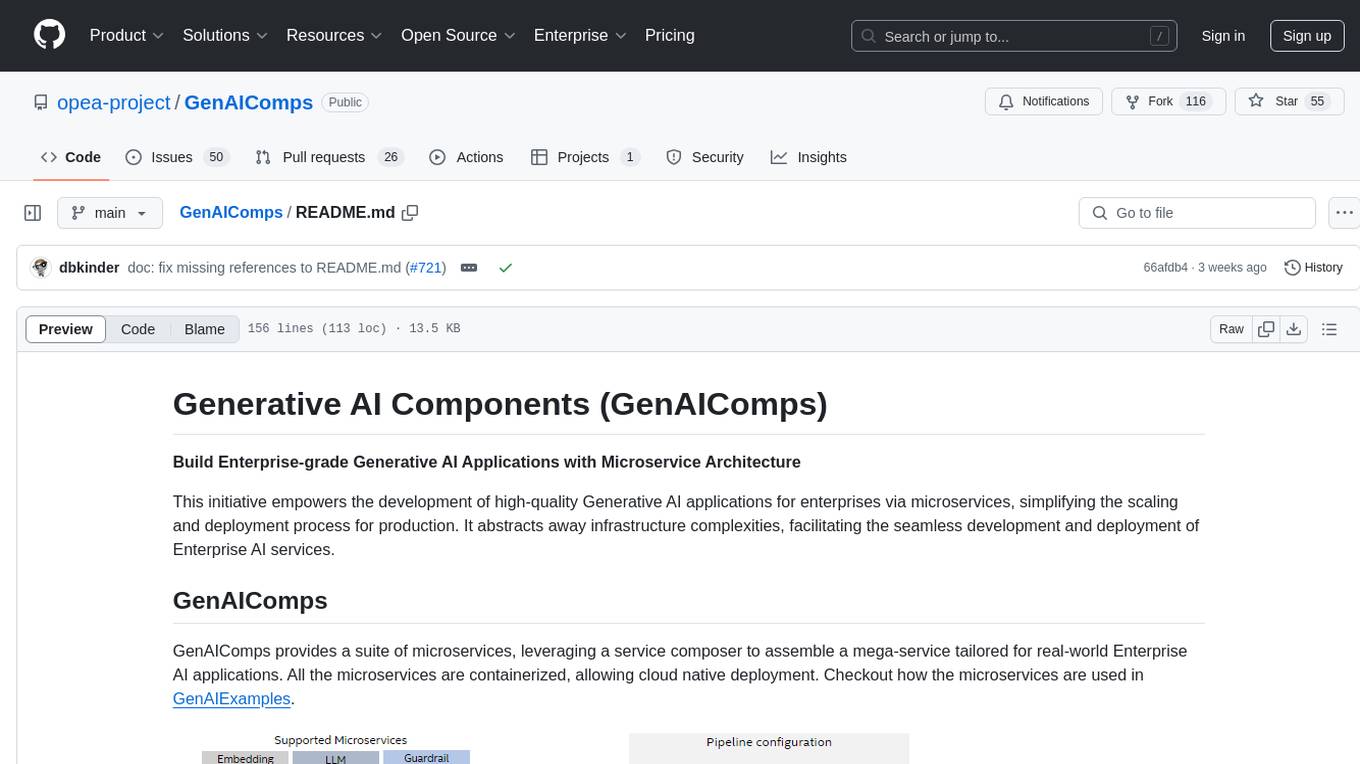
GenAIComps
GenAIComps is an initiative aimed at building enterprise-grade Generative AI applications using a microservice architecture. It simplifies the scaling and deployment process for production, abstracting away infrastructure complexities. GenAIComps provides a suite of containerized microservices that can be assembled into a mega-service tailored for real-world Enterprise AI applications. The modular approach of microservices allows for independent development, deployment, and scaling of individual components, promoting modularity, flexibility, and scalability. The mega-service orchestrates multiple microservices to deliver comprehensive solutions, encapsulating complex business logic and workflow orchestration. The gateway serves as the interface for users to access the mega-service, providing customized access based on user requirements.
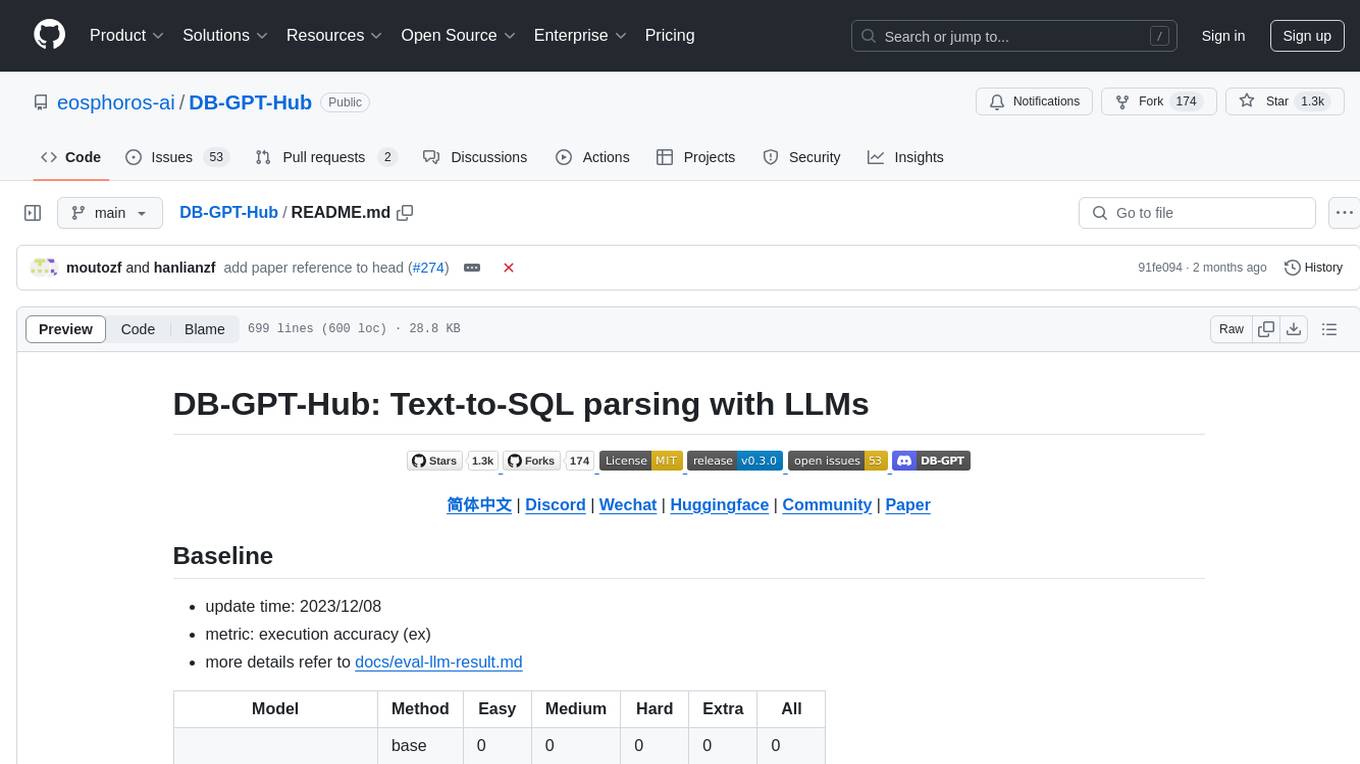
DB-GPT-Hub
DB-GPT-Hub is an experimental project leveraging Large Language Models (LLMs) for Text-to-SQL parsing. It includes stages like data collection, preprocessing, model selection, construction, and fine-tuning of model weights. The project aims to enhance Text-to-SQL capabilities, reduce model training costs, and enable developers to contribute to improving Text-to-SQL accuracy. The ultimate goal is to achieve automated question-answering based on databases, allowing users to execute complex database queries using natural language descriptions. The project has successfully integrated multiple large models and established a comprehensive workflow for data processing, SFT model training, prediction output, and evaluation.
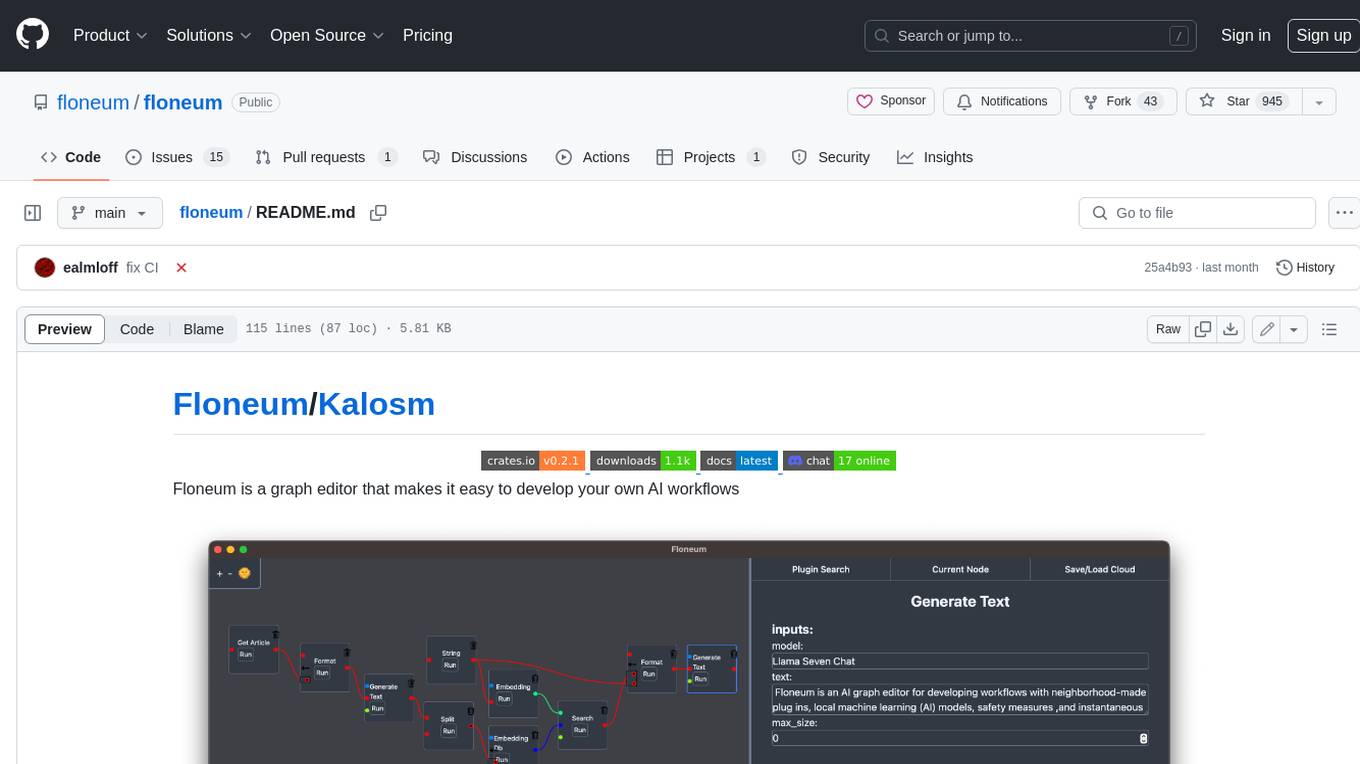
floneum
Floneum is a graph editor that makes it easy to develop your own AI workflows. It uses large language models (LLMs) to run AI models locally, without any external dependencies or even a GPU. This makes it easy to use LLMs with your own data, without worrying about privacy. Floneum also has a plugin system that allows you to improve the performance of LLMs and make them work better for your specific use case. Plugins can be used in any language that supports web assembly, and they can control the output of LLMs with a process similar to JSONformer or guidance.
For similar tasks

AV-Deepfake1M
The AV-Deepfake1M repository is the official repository for the paper AV-Deepfake1M: A Large-Scale LLM-Driven Audio-Visual Deepfake Dataset. It addresses the challenge of detecting and localizing deepfake audio-visual content by proposing a dataset containing video manipulations, audio manipulations, and audio-visual manipulations for over 2K subjects resulting in more than 1M videos. The dataset is crucial for developing next-generation deepfake localization methods.
For similar jobs

weave
Weave is a toolkit for developing Generative AI applications, built by Weights & Biases. With Weave, you can log and debug language model inputs, outputs, and traces; build rigorous, apples-to-apples evaluations for language model use cases; and organize all the information generated across the LLM workflow, from experimentation to evaluations to production. Weave aims to bring rigor, best-practices, and composability to the inherently experimental process of developing Generative AI software, without introducing cognitive overhead.

agentcloud
AgentCloud is an open-source platform that enables companies to build and deploy private LLM chat apps, empowering teams to securely interact with their data. It comprises three main components: Agent Backend, Webapp, and Vector Proxy. To run this project locally, clone the repository, install Docker, and start the services. The project is licensed under the GNU Affero General Public License, version 3 only. Contributions and feedback are welcome from the community.

oss-fuzz-gen
This framework generates fuzz targets for real-world `C`/`C++` projects with various Large Language Models (LLM) and benchmarks them via the `OSS-Fuzz` platform. It manages to successfully leverage LLMs to generate valid fuzz targets (which generate non-zero coverage increase) for 160 C/C++ projects. The maximum line coverage increase is 29% from the existing human-written targets.

LLMStack
LLMStack is a no-code platform for building generative AI agents, workflows, and chatbots. It allows users to connect their own data, internal tools, and GPT-powered models without any coding experience. LLMStack can be deployed to the cloud or on-premise and can be accessed via HTTP API or triggered from Slack or Discord.

VisionCraft
The VisionCraft API is a free API for using over 100 different AI models. From images to sound.

kaito
Kaito is an operator that automates the AI/ML inference model deployment in a Kubernetes cluster. It manages large model files using container images, avoids tuning deployment parameters to fit GPU hardware by providing preset configurations, auto-provisions GPU nodes based on model requirements, and hosts large model images in the public Microsoft Container Registry (MCR) if the license allows. Using Kaito, the workflow of onboarding large AI inference models in Kubernetes is largely simplified.

PyRIT
PyRIT is an open access automation framework designed to empower security professionals and ML engineers to red team foundation models and their applications. It automates AI Red Teaming tasks to allow operators to focus on more complicated and time-consuming tasks and can also identify security harms such as misuse (e.g., malware generation, jailbreaking), and privacy harms (e.g., identity theft). The goal is to allow researchers to have a baseline of how well their model and entire inference pipeline is doing against different harm categories and to be able to compare that baseline to future iterations of their model. This allows them to have empirical data on how well their model is doing today, and detect any degradation of performance based on future improvements.

Azure-Analytics-and-AI-Engagement
The Azure-Analytics-and-AI-Engagement repository provides packaged Industry Scenario DREAM Demos with ARM templates (Containing a demo web application, Power BI reports, Synapse resources, AML Notebooks etc.) that can be deployed in a customer’s subscription using the CAPE tool within a matter of few hours. Partners can also deploy DREAM Demos in their own subscriptions using DPoC.







